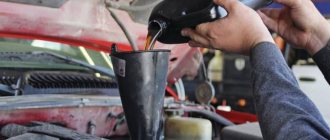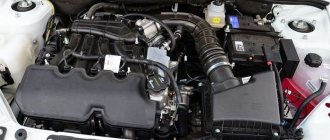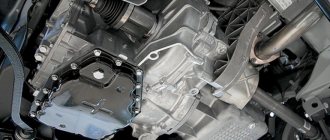The VAZ 21127 engine emerged in 2013 from the 21126 engine, completely retaining its design. Changes have been made to the design of the intake manifold - in the unit combined with the receiver, which was already used in the previous version, the developers installed dampers to regulate air flows.
ICE 21127
This, in turn, required the abandonment of the DMVR sensor; instead, DTV and DBP (air temperature and absolute pressure, respectively) are used. In other words, the designers have produced budget tuning, which is usually used by owners to independently increase engine power.
Design changes
The 21127 engine was created from the previous modification 21126 of the 2112 engine, so the main design remained the same:
- cylinder head – used from the first version 21124;
- gas distribution mechanism – DOHC scheme, two camshafts, phased injection;
- cylinder block – high type from 11183, cylinder surfaces are honed;
- connecting rod and piston group - lightweight, foreign made;
- Timing drive – belt, tooth profile rounded;
- exhaust tract - catalytic collector with a large landing size of the neutralizer;
- crankshaft - with a “long” crank radius, from 11183;
- flywheel – has a chamfer for a large diameter damper;
- ignition system – there is a separate coil for each spark plug, there are no high-voltage wires;
- fuel system – ramp with imported injectors (Siemens, Bosch);
- electronic motor control system – controllers M7.9.7 or January 7.2;
- attachments - a pump with a metal impeller has a long service life.
Receiver 21127
Fuel rail 21127
“As a legacy”, the 21127 engine received ultra-low oil consumption - only 0.1% of the amount of oil used by the system. However, for the operation of the valve and hydraulic lifter cooling system, the AvtoVAZ manufacturer’s operating manual recommends purchasing exclusively high-quality lubricant, which costs 10% more.
Engine VAZ 21179
An absolute novelty in the Lada brand engine lineup. For the first time in a passenger car division, the engine received a volume of 1.8 liters. If behind the external similarity in this engine one can discern the features of its previous 16-valve counterparts, then internally it is a completely new engine, and of its own design.
The list of qualitative changes could take a long time, but it will hardly be of interest to the average user, so let’s focus on the main aspects. Unlike previous models, this engine, coupled with a lightweight piston group, also received lightweight valves, an oil pump of increased power, the cylinder head received additional oil channels that deliver fluid to the new phase shifter, although so far only at the inlet. The camshafts themselves are imported, lightweight
The cooling system has been improved, an imported water pump of greater power and high reliability has been used. The engine systems are controlled similarly to the VAZ 21127 model through DBP and DTV, and not through the previously familiar mass air flow sensor, which also has a positive effect on reliability and stability of operation.
The domestically produced intake tract was made specifically for the characteristics of the new engine.
A qualitatively new approach to the development, processing and creation of the engine allowed the manufacturer to set a rated service life of 220 thousand kilometers, which is so far the best indicator among all engines produced at AvtoVAZ. The real resource indicator with careful operation and high-quality care is predicted at the level of 400 thousand kilometers.
The new engine is adapted for the use of cheaper fuel with an octane number of AI-92, however, according to the plant’s recommendation, power characteristics will be higher with higher quality AI-95 fuel.
Passport data: maximum power 122 hp, maximum torque 172 N/m. The engine received a flat torque plateau, which allows it to achieve a torque of 127 N/m at a speed of 1000 per minute, which is 7 N/m higher than the maximum performance of the base VAZ 11183 engine.
The engine is currently used on Lada Vesta and Lada X-Ray cars, but during its creation the possibility of placing it in older Lada products was taken into account, including, possibly, the 4x4 line, which is being prepared for a thorough restyling. This is evidenced by two platforms for the engine number for longitudinal and transverse placement of the engine in the engine compartment.
Pros:
- Qualitatively new indicators on the level of power supply;
- Plenty of torque at low revs.
Minuses:
Due to its novelty, there are no service statistics.
Pros and cons of the motor
The main feature of the ICE 21127 remains the insufficient safety of the valves, which can be bent by the pistons if the timing belt breaks. The second disadvantage is the expensive overhaul, even if you do it yourself:
- the timing belt complete with automatic tensioner and pulley is expensive, as it is produced by the foreign company Gates;
- The ShPG kit also has a high price, since it is manufactured by another foreign manufacturer, Federal Mogul.
Damper control valve
The advantages of the design are:
- attachments are conveniently located, which reduces labor costs for maintenance and repairs;
- increased torque and power of the internal combustion engine.
On the one hand, the manufacturer AvtoVAZ has expanded its line of engines with version 21127. On the other hand, it has provided a new spare part - an improved receiver with an inertial charging system, which is a definite plus:
- owners of Grant, Prior and Kalin of the second generation, equipped with 21126 engines, can buy this unit;
- install it yourself instead of the standard receiver of the previous configuration;
- remove the mass air flow sensor, install DBP and DTV sensors to get a power of 106 hp. With. instead of the factory 98 hp. With.
There are no other changes in the design of the internal combustion engine; there is no need to re-register the car with the traffic police. Transport tax and insurance will be cheaper, since the plant’s vehicle certificate indicates less power.
Engine characteristics
| Manufacturer | AvtoVAZ |
| Engine brand | 21127 |
| Years of production | 2013 — … |
| Volume | 1597 cm 3 (1.6 l) |
| Power | 78 kW (106 hp) |
| Torque moment | 148 Nm (at 5800 rpm) |
| Weight | 116 kg |
| Compression ratio | 11 |
| Nutrition | injector |
| Motor type | in-line |
| Injection | distributed electronically controlled |
| Ignition | coil for each spark plug |
| Number of cylinders | 4 |
| Location of the first cylinder | TVE |
| Number of valves on each cylinder | 4 |
| Cylinder head material | aluminum alloy |
| Intake manifold | combined with receiver, polymer, built-in damper, DTV and DBP sensors |
| An exhaust manifold | catalyst |
| Camshaft | 2 pcs., marks on pulleys are offset by 2 degrees |
| Cylinder block material | cast iron |
| Cylinder diameter | 82 mm |
| Pistons | lightweight, manufacturer Federal Mogul |
| Crankshaft | from 11183 |
| Piston stroke | 75.6 mm |
| Fuel | AI-95 |
| Environmental standards | Euro 4/5 |
| Fuel consumption | highway - 5.8 l/100 km combined cycle 7 l/100 km city - 9.6 l/100 km |
| Oil consumption | maximum 0.1 l/1000 km |
| What kind of oil to pour into the engine by viscosity | 5W-30 and 10W-40 |
| Which engine oil is best by manufacturer | Liqui Moly, LukOil, Rosneft, Mannol |
| Oil for 21127 according to composition | synthetics, semi-synthetics |
| Engine oil volume | 3.5 l |
| Operating temperature | 95° |
| Motor life | declared 200,000 km actual 300,000 km |
| Adjustment of valves | hydraulic compensators |
| Cooling system | forced, antifreeze |
| Coolant quantity | 7.8 l |
| water pump | with metal impeller |
| Candles for 21127 | BCPR6ES from NGK or domestic AU17DVRM |
| Gap between spark plug electrodes | 1.1 mm |
| Timing belt | Gates, width 22 mm, service life 200,000 km |
| Cylinder operating order | 1-3-4-2 |
| Air filter | Nitto, Knecht, Fram, WIX, Hengst |
| Oil filter | catalog number 90915-10001 replacement 90915-10003, with check valve |
| Flywheel | increased damper size |
| Flywheel mounting bolts | box MT - M10x1.25 mm, length 26 mm, groove 11 mm box AT - M10x1.25 mm, length 26 mm without groove |
| Valve stem seals | code 90913-02090 inlet light code 90913-02088 exhaust dark |
| Compression | from 12 bar, difference in adjacent cylinders maximum 1 bar |
| XX speed | 800 - 850 min -1 |
| Tightening force of threaded connections | spark plug - 31 - 39 Nm flywheel - 62 - 87 Nm clutch bolt - 19 - 30 Nm bearing cap - 68 - 84 Nm (main) and 43 - 53 (rod) cylinder head - three stages 20 Nm, 69 - 85 Nm + 90° + 90° |
The engine is installed on:
Lada Priora Lada Kalina 2 Lada Granta
Pros and cons of the VAZ-21127 engine
Pros:
— improved engine elasticity — solution to the problem of floating speed at idle
Cons:
— The cost of transport tax increases sharply, because engine more powerful than 100 hp — If the timing belt breaks, the engine still bends the valves — A car with this engine costs more
Which cars are equipped with ICE 21127?
Immediately after development, engine 21127 is recommended to be installed on cars manufactured by AvtoVAZ:
- Lada Granta - since 2013, Lux and Norma configurations;
- Lada Kalina-2 - since 2013, only with a manual transmission, mainly on sedans and hatchbacks;
- Lada Priora - since 2013, Luxury equipment.
Lada Priora Luxe configuration
In principle, the engine’s sufficiently high performance characteristics made it possible to install it on the Lada Largus, Vesta and X-Ray. However, by the time of their serial production, the ICE 21127 had been upgraded to the next version 21129 with a control unit that complies with Euro-5 standards, so the plant management limited itself to the indicated modifications, leaving the volumes the same.
Motor 21129
Maintenance
In order to carry out major overhauls as rarely as possible, it is recommended to service engine 21127 according to the regulations:
- The timing belt drives the timing pulleys for 20–50 thousand km, but it needs to be inspected three times more often;
- The oxygen sensor has a slightly shorter service life - 10 thousand hours;
- The cooling system and the antifreeze itself, filters and fuel tank cap can withstand 40 thousand km of operation;
- the threshold of 25 thousand mileage cannot be overcome by spark plugs, belts and attachment belts;
- The filter along with the oil is changed every 10 thousand km.
To save budget, the internal combustion engine device allows you to perform all the specified maintenance operations in the garage without visiting service stations.
General recommendations for choosing oil
Regardless of what kind of engine your car has, there are general recommendations that will prevent you from making mistakes. First of all, we are talking about the advice of the car manufacturer. As a rule, these are precise indications of which liquids are best suited. In this case, it is necessary to take into account the characteristics of the area in which the machine will be operated.
Type of oil for specific operating conditions
The second point will be the engine wear factor and what kind of oil was poured into it previously.
For example, if the car previously had semi-synthetics, then there is a possibility that sediment plugs may form in small cracks in the rubber . And, when changing the oil to synthetic, all this will be washed out, and the compression characteristics of certain components will be impaired. But, if semi-synthetics are still relatively normal, then mineral oil brings many problems during long-term operation.
Typical breakdowns, causes, elimination
Since the 21127 motor uses a lightweight ShPG, as a result of a sudden belt break, the piston is 100% guaranteed to bend the valve. In addition, there are “diseases” characteristic of this motor:
| Power reduction | 1) burnt out valves 2) clogged air filter 3)fuel system malfunction 4) clutch slipping 5) wear of camshaft cams | 1)replacement of valves 2) cleaning or replacing consumables 3) cleaning and repair 4) clutch replacement 5) installation of a new camshaft |
| The internal combustion engine runs after the ignition is turned off | 1) carbon deposits inside the combustion chambers and on the valves 2) Problems with the ignition switch | 1)washing with a cleaning agent 2)replacing the ignition switch |
| Emergency pressure lamp comes on | 1) wear of the oil pump or main bearings 2) short circuit 3)low oil level | 1) replacement of parts 2) electrical repair 3) adding lubricant to the level |
In principle, no special complaints were noticed with the ICE 21127; this power drive is considered reliable and economical to operate.
Engine tuning
Initially, engine 21127 had already received factory tuning, but there were still opportunities to further increase power:
- In addition to the standard receiver, a damper with a diameter of 54 mm is mounted to achieve a performance of about 110 liters. With.;
- another 10 l. With. will be added by replacing the exhaust catifold with a “spider”;
- The Stolnikov camshaft modification 8.9 will provide power in the upper speed range.
Tuning 21127
Complex tuning is possible by installing a Stolnikov 9.15 camshaft with a phase shift of 316 degrees, replacing injectors with Bosch 431 360 (more efficient compared to standard ones) and milling the valve seat stages. In this case, the internal combustion engine will receive about 150 hp. With.
Thus, motor 21127 is an industrially tuned version of the previous internal combustion engine 21126. The characteristics are improved only by modifying the intake air system (damper inside the receiver plus DBP, DTV).
If you have any questions, leave them in the comments below the article. We or our visitors will be happy to answer them
Malfunctions and repairs of the new 21127 Priora engine
Engine VAZ 21127 1.6 l. 106 hp a new VAZ engine, a continuation of the Prior engine 21126 and based on the same modified block 21083. The engine is an in-line 4-cylinder injection engine with overhead camshafts, the gas distribution mechanism is belt driven. A special feature of the 127 engine is that it was equipped with an intake system with a resonance chamber with an adjustable volume: controlled flaps reduce or increase its volume depending on the number of revolutions per minute. The chamber volume varies from larger to smaller, and the minimum volume value is used in the mode from 3500 rpm. In addition, now instead of the mass air flow sensor, DBP+DTV is installed, along with the mass air flow sensor the problem of floating speeds has gone away, and this is where the differences between the 126 and 127 engines end. At the same time, the 21127 Priors engine still bends the valves, the other problems remain the same, noise, knocking, tripping... the reasons that give rise to them are described in the article about the 126 engine. According to the sensations and reviews, the engine began to drive more interesting from the bottom than the usual 126 engine, at the top the situation is the same, the changes are insignificant, but noticeable.
Since 2015, production of a restyled version of this engine began, which was called 21129 or popularly known as the Vesta engine.











